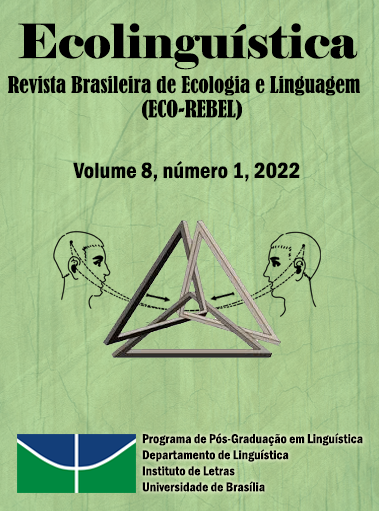Ecolinguística E antropologia do imaginário
Keywords:
Ecolinguística; Aquisição de língua e imagem; Imaginário; Transdisciplinaridade.Abstract
Diálogo entre Ecolinguística e imaginário é possível e desejável. A primeira é o estudo das relações entre língua e meio ambiente (natural, mental, social). O natural tem a ver com o lado biológico da linguagem e por ela existir para os humanos comunicarem entre si sobre o mundo. O mental se deve ao fato de a língua nascer, estar armazenada e processada no cérebro. O social é onde tudo é sancionado. Na Antropologia do Imaginário, vê-se que a imaginação é uma faculdade que se realiza inicialmente pela observação, percepção, memorização e reprodução das coisas do mundo natural. O imaginário é a modalidade pela qual cada indivíduo e cada cultura manifestam essa faculdade. A Antropologia do Imaginário de Durand se concentra no estudo das imagens mentais cristalizadas em signos, ícones ou símbolos. Essas afinidades entre as duas áreas vêm sendo estudadas na UFG, complementando o que se faz em Ecolinguística na UnB.
Downloads
Published
Issue
Section
License

This work is licensed under a Creative Commons Attribution-NonCommercial-NoDerivatives 4.0 International License.
Authors who publish in this journal agree to the following terms:
Authors retain copyright and grant the journal the right of first publication. The work is simultaneously licensed under the Creative Commons Attribution License allowing the sharing of the work with acknowledgment of the authorship of the work and initial publication in this journal.
Authors are authorized to enter into additional contracts separately for non-exclusive distribution of the version of the work published in this journal (e.g., publishing in institutional repositories or as book chapters), with acknowledgment of authorship and initial publication in this journal.
Authors are allowed and encouraged to post and distribute their work online (e.g., in institutional repositories or on their personal page) at any point before or during the editorial process, as this can bring about productive revisions as well as increase impact.
Citation of published works (See The Effect of Free Access).



3.png)



